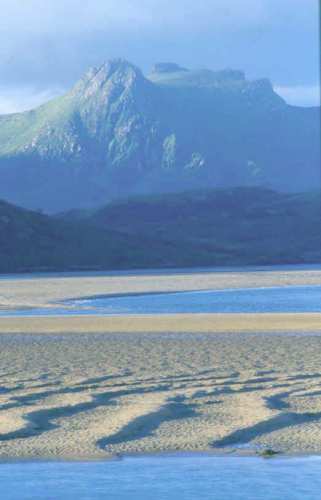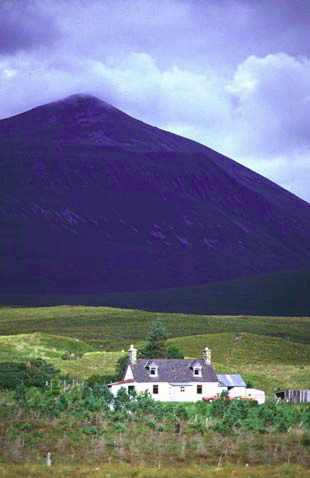|
Climate
West Sutherland experiences a much wetter climate than the East, but
temperatures are generally higher due to the moderating effect of the
North Atlantic Drift, an oceanic current that starts as the Gulf Stream in
the Gulf of Mexico. Central and East Sutherland is in the rain shadow of
the hills on the West, and is noticeably drier. However, winter
temperatures away from the coast are generally lower and so Mid Sutherland
can receive more snow and frost.

Ben Layal
A crucial factor in soil
development on the West is the oceanic climate. Rainfall is high, summers
are cool and winters are relatively mild. The interaction between climate
and the underlying rock and glacial debris determines soil development
and, from that, the different types of vegetation that we see today.
Altitude too has a profound effect. At higher altitudes average
temperatures are much lower, wind speeds are greater, freeze-thaw cycles
disturb root systems and recycling of nutrients is much slower. In
Sutherland, this altitudinal effect is compressed because of the cool
summer temperatures, and consequently we see species or communities at or
near sea level that would normally only occur higher up the mountains.
Climate change is an issue of concern these days. However, it should be
noted that our climate has been getting progressively warmer since the
last glaciation, and that Sutherland’s vegetation and animal life has been
responding accordingly. This is illustrated by an increase and decline in
tree cover.
|
Human Impact
The third major influence on the wildlife of Sutherland is of course,
human impact. When the ice melted, much of Sutherland was slowly colonised
by trees, evidence of which can be seen in
the deep peat today. Humans cleared much of this woodland and converted it
to an agricultural landscape, which continued relatively unchanged for
thousands of years.
During the Clearances of the early
to mid 19th Century, people were moved off the inland straths to the
coasts, to be replaced by vast flocks of sheep.
The sheep, in turn, were replaced by deer ‘forests’, and deer stalking
remains the dominant land-use interest in much of inland Sutherland today.
Crofting was initiated as a land use, based on small in-bye units
augmented by areas of common grazing. The coastal population peaked during
the mid 19th Century, and many people left to find work elsewhere. In more
recent times, cultivation has almost ceased in West Sutherland in favour
of sheep grazing, and the population of East Sutherland has expanded.
From east to west and north to
south, the underlying geology, changing climate and human impact has
determined the presence and abundance
of many of Sutherland’s plants and animals. Small cranberry, for example,
has a distinctly eastern distribution, whilst dwarf birch is restricted to
central parts and black bog rush is generally found to the west.

Crofthouse, Mid Sutherland
|

